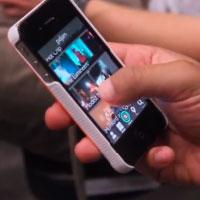
Video by Efren Salinas, graduate journalism student.
What do you get when you bring journalism students together with computer science students? Five teams working on creating mobile apps and getting them into the iPhone app store by semester’s end.
Robert Quigley, a senior lecturer in journalism, designed the class not knowing whether that expectation could be met. But by App Demo Day, on April 27, the proof was in the presentations.
Journalism students learned code, while computer science students learned more about the journalism industry. Teams pitched, designed, coded and marketed their apps through blog posts and social media, with help from local entrepreneur Joshua McClure.
“Journalists and computer scientists are carrying similar tool boxes these days so we’re trying to learn each other’s language,” says Wanda Garner Cash, associate director of the School of Journalism and one of the competition’s judges. Cash adds the course is a good example of how the School of Journalism’s new undergraduate curriculum is synching with changes in the news and information business.
At Demo Day on April 27, judges named Glos Guide — an ioS AP Style reference guide and study tool — the Best Overall App. Available on iTunes, the 99-cent app includes style rules, bookmarks capability and journalistic tips.
“Because this class is in the School of Journalism, we thought, ‘Why not make an app to help journalism students?’” says Monica Zhang, Glos Guide team member and senior journalism student.
“It’s a tremendous calling card for any student,” says Rodney Gibbs, a competition judge and chief innovation officer for The Texas Tribune, who believes the app-building experience will set students apart from 75 percent of journalism job applicants.
“A successful applicant to our organization cannot survive on writing alone. He must at least be able to collaborate with technologists — be they app developers, data journalists or programmers. And if he has experience creating an app, managing a tech team and finding a market for his app? That’s like an actor who can sing and dance, too. In showbiz they call that person a triple-threat,” Gibbs says.
Other apps included:
Pxljam, a photo-sharing app that bridges fans and music artists (Voted “Best Design” and “Best Commercial Value”)
PicBook, an iPad app that aggregates Facebook photos and allows users to create scrapbooks (Voted “Most Original”)
Prix-Party, a Formula 1 Austin event guide (Voted “Best Presentation”)
Nerv, an app that provides local, social news for urban travelers
Judges included Cash; Gibbs; Gerald Bailey, founder of SnakeHead Software; Carmen Cano, general manager, digital and innovation at The Dallas Morning News; Debbie Hiott, editor of The Austin American-Statesman; and Christopher Visit, founding principal of Frank+Victor Design.
In the fall of 2013, the School of Journalism will offer a similar class: Introduction to Mobile Programming for Journalists. The course will prepare journalism students for Mobile News App Design, which will be offered again in the spring of 2014.



